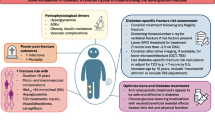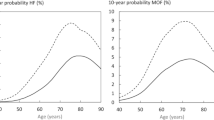Abstract
Summary
People with both HIV and hepatitis C are more likely than those with HIV alone to have wrist, hip, and spine fractures. We compared hip strength between HIV/HCV-co-infected men and healthy men and found that HIV/HCV-co-infected men had decreased hip strength due to lower lean body mass.
Introduction
Hepatitis C co-infection is a risk factor for fragility fracture among HIV-infected populations. Whether bone strength is compromised in HIV/HCV-co-infected patients is unknown.
Methods
We compared dual-energy x-ray absorptiometry (DXA)-derived hip geometry, a measure of bone strength, in 88 HIV/HCV-co-infected men from the Johns Hopkins HIV Clinic to 289 men of similar age and race and without HIV or HCV from the Boston Area Community Health Survey/Bone Survey. Hip geometry was assessed at the narrow neck, intertrochanter, and shaft using hip structural analysis. Lean body mass (LBM), total fat mass (FM), and fat mass ratio (FMR) were measured by whole-body DXA. Linear regression was used to identify body composition parameters that accounted for differences in bone strength between cohorts.
Results
HIV/HCV-co-infected men had lower BMI, LBM, and FM and higher FMR compared to controls (all p < 0.05). At the narrow neck, significant differences were observed between HIV/HCV-co-infected men and controls in bone mineral density, cross-sectional area, section modulus, buckling ratio, and centroid position. After adjustment for race, age, smoking status, height, and weight, only buckling ratio and centroid position remained significantly different between cohorts (all p < 0.05). Substituting LBM, FM, and FMR for weight in the multivariate model revealed that differences in LBM, but not FM or FMR, accounted for differences in all narrow neck parameters between cohorts, except buckling ratio and centroid position.
Conclusion
HIV/HCV-co-infected men have compromised hip strength at the narrow neck compared to uninfected controls, which is attributable in large part to lower lean body mass.

Similar content being viewed by others
References
Brown TT, Qaqish RB (2006) Antiretroviral therapy and the prevalence of osteopenia and osteoporosis: a meta-analytic review. AIDS 20:2165–2174
Gallant JE, Staszewski S, Pozniak AL, DeJesus E, Suleiman JM, Miller MD, Coakley DF, Lu B, Toole JJ, Cheng AK (2004) Efficacy and safety of tenofovir DF vs stavudine in combination therapy in antiretroviral-naive patients: a 3-year randomized trial. JAMA 292:191–201
Tebas P, Powderly WG, Claxton S, Marin D, Tantisiriwat W, Teitelbaum SL, Yarasheski KE (2000) Accelerated bone mineral loss in HIV-infected patients receiving potent antiretroviral therapy. AIDS 14:F63–F67
Tebas P, Umbleja T, Dube M (2007) Initiation of ART is associated with bone loss independent of the specific ART regimen: results of ACTG A5005s. 14th Conference on Retroviruses and Opportunistic Infections. Los Angeles
Womack JA, Goulet JL, Gibert C, Brandt C, Chang CC, Gulanski B, Fraenkel L, Mattocks K, Rimland D, Rodriguez-Barradas MC, Tate J, Yin MT, Justice AC, Veterans Aging Cohort Study Project Team (2011) Increased risk of fragility fractures among HIV infected compared to uninfected male veterans. PLoS ONE 6:e17217
Collin F, Duval X, Le Moing V, Piroth L, Al Kaied F, Massip P, Villes V, Chene G, Raffi F (2009) Ten-year incidence and risk factors of bone fractures in a cohort of treated HIV1-infected adults. AIDS 23:1021–1024
Dao C YB, Buchacz K, Baker R, Brooks J (2010) Higher and increasing rates of fracture among HIV-infected persons in the HIV outpatient study compared to the general US population, 1994–1998. Abstracts of the 17th Conference on Retroviruses and Opportunistic Infections. San Francisco
Volk J, Localio R, Newcomb C, Yang Y, Hennessy S, Kostman J, Tebas P, Leonard M, Lo Re III V (2011) Risk of fractures associated with HIV/hepatitis C coinfection. Abstracts of the 18th Conference on Retroviruses and Opportunistic Infections. Boston
Yin MT, Kendall MA, Wu X, Tassiopoulos K, Huang JS, Shane E, Hochberg M, McComsey GA (2011) Incidence and determinants of fracture in HIV+ individuals on ART in the ALLRT Study. Abstracts of the 18th Conference on Retroviruses and Opportunistic Infections. Boston
Marshall D, Johnell O, Wedel H (1996) Meta-analysis of how well measures of bone mineral density predict occurrence of osteoporotic fractures. BMJ 312:1254–1259
El-Maouche D, Xu X, Cofrancesco J Jr, Dobs AS, Brown TT (2011) Prevalence of low bone mineral density in a low-income inner-city population. J Bone Miner Res 26:388–396
Cazanave C, Dupon M, Lavignolle-Aurillac V, Barthe N, Lawson-Ayayi S, Mehsen N, Mercie P, Morlat P, Thiebaut R, Dabis F (2008) Reduced bone mineral density in HIV-infected patients: prevalence and associated factors. AIDS 22:395–402
Paul SM, Martin RM, Lu SE, Lin Y (2007) Changing trends in human immunodeficiency virus and acquired immunodeficiency syndrome in the population aged 50 and older. J Am Geriatr Soc 55:1393–1397
Olszynski WP, Shawn Davison K, Adachi JD, Brown JP, Cummings SR, Hanley DA, Harris SP, Hodsman AB, Kendler D, McClung MR, Miller PD, Yuen CK (2004) Osteoporosis in men: epidemiology, diagnosis, prevention, and treatment. Clin Ther 26:15–28
Cummings SR, Black D (1995) Bone mass measurements and risk of fracture in Caucasian women: a review of findings from prospective studies. Am J Med 98:24S–28S
De Laet C, Oden A, Johansson H, Johnell O, Jonsson B, Kanis JA (2005) The impact of the use of multiple risk indicators for fracture on case-finding strategies: a mathematical approach. Osteoporos Int 16:313–318
Edelstein SL, Barrett-Connor E (1993) Relation between body size and bone mineral density in elderly men and women. Am J Epidemiol 138:160–169
Hannan MT, Felson DT, Anderson JJ (1992) Bone mineral density in elderly men and women: results from the Framingham osteoporosis study. J Bone Miner Res 7:547–553
Moore RD (1998) Understanding the clinical and economic outcomes of HIV therapy: the Johns Hopkins HIV clinical practice cohort. J Acquir Immune Defic Syndr Hum Retrovirol 17(Suppl 1):S38–S41
Araujo AB, Travison TG, Harris SS, Holick MF, Turner AK, McKinlay JB (2007) Race/ethnic differences in bone mineral density in men. Osteoporos Int 18:943–953
Travison TG, Beck TJ, Esche GR, Araujo AB, McKinlay JB (2008) Age trends in proximal femur geometry in men: variation by race and ethnicity. Osteoporos Int 19:277–287
Bonnet E, Delpierre C, Sommet A, Marion-Latard F, Herve R, Aquilina C, Labau E, Obadia M, Marchou B, Massip P, Perret B, Bernard J (2005) Total body composition by DXA of 241 HIV-negative men and 162 HIV-infected men: proposal of reference values for defining lipodystrophy. J Clin Densitom 8:287–292
Travison TG, Araujo AB, Esche GR, Beck TJ, McKinlay JB (2008) Lean mass and not fat mass is associated with male proximal femur strength. J Bone Miner Res 23:189–198
Beck T (2003) Measuring the structural strength of bones with dual-energy X-ray absorptiometry: principles, technical limitations, and future possibilities. Osteoporos Int 14(Suppl 5):S81–S88
Beck TJ, Looker AC, Ruff CB, Sievanen H, Wahner HW (2000) Structural trends in the aging femoral neck and proximal shaft: analysis of the Third National Health and Nutrition Examination Survey dual-energy X-ray absorptiometry data. J Bone Miner Res 15:2297–2304
Beck TJ (2007) Extending DXA beyond bone mineral density: understanding hip structure analysis. Curr Osteoporos Rep 5:49–55
LaCroix AZ, Beck TJ, Cauley JA, Lewis CE, Bassford T, Jackson R, Wu G, Chen Z (2010) Hip structural geometry and incidence of hip fracture in postmenopausal women: what does it add to conventional bone mineral density? Osteoporos Int 21:919–929
Rosenthall L, Falutz J (2005) Bone mineral and soft-tissue changes in AIDS-associated lipoatrophy. J Bone Miner Metab 23:53–57
Triant VA, Brown TT, Lee H, Grinspoon SK (2008) Fracture prevalence among human immunodeficiency virus (HIV)-infected versus non-HIV-infected patients in a large U.S. healthcare system. J Clin Endocrinol Metab 93:3499–3504
Yin MT, Shi Q, Hoover DR, Anastos K, Sharma A, Young M, Levine A, Cohen MH, Shane E, Golub ET, Tien PC (2010) Fracture incidence in HIV-infected women: results from the Women's Interagency HIV Study. Aids 24:2679–2686
El-Maouche D, Shruti, Mehta, Sutcliffe C, Higgins Y, Torbenson M, Moore R, Thomas DL, Sulkowski M, Brown TT (2011) Controlled HIV viral replication, not liver disease severity associated with low bone mineral density in HIV/HCV co-infection. J Hepatol (in press)
Lo Re V 3rd, Guaraldi G, Leonard MB, Localio AR, Lin J, Orlando G, Zirilli L, Rochira V, Kostman JR, Tebas P (2009) Viral hepatitis is associated with reduced bone mineral density in HIV-infected women but not men. AIDS 23:2191–2198
Kaptoge S, Beck TJ, Reeve J, Stone KL, Hillier TA, Cauley JA, Cummings SR (2008) Prediction of incident hip fracture risk by femur geometry variables measured by hip structural analysis in the study of osteoporotic fractures. J Bone Miner Res 23:1892–1904
Sheu Y, Zmuda JM, Boudreau RM, Petit MA, Ensrud KE, Bauer DC, Gordon CL, Orwoll ES, Cauley JA (2011) Bone strength measured by peripheral quantitative computed tomography and the risk of nonvertebral fractures: the osteoporotic fractures in men (MrOS) study. J Bone Miner Res 26:63–71
Shikuma CM, Zackin R, Sattler F, Mildvan D, Nyangweso P, Alston B, Evans S, Mulligan K (2004) Changes in weight and lean body mass during highly active antiretroviral therapy. Clin Infect Dis 39:1223–1230
George J, Ganesh HK, Acharya S, Bandgar TR, Shivane V, Karvat A, Bhatia SJ, Shah S, Menon PS, Shah N (2009) Bone mineral density and disorders of mineral metabolism in chronic liver disease. World J Gastroenterol 15:3516–3522
Neff GW, O'Brien CB, Shire NJ, DeManno A, Kahn S, Rideman E, Safdar K, Madariaga J, Rudich SR (2004) Topical testosterone treatment for chronic allograft failure in liver transplant recipients with recurrent hepatitis C virus. Transplant Proc 36:3071–3074
Zhao LJ, Liu YJ, Liu PY, Hamilton J, Recker RR, Deng HW (2007) Relationship of obesity with osteoporosis. J Clin Endocrinol Metab 92:1640–1646
Dube MP, Parker RA, Mulligan K, Tebas P, Robbins GK, Roubenoff R, Grinspoon SK (2007) Effects of potent antiretroviral therapy on free testosterone levels and fat-free mass in men in a prospective, randomized trial: A5005s, a substudy of AIDS Clinical Trials Group Study 384. Clin Infect Dis 45:120–126
Reid IR (2010) Fat and bone. Arch Biochem Biophys 503:20–27
Brown TT, Ruppe MD, Kassner R, Kumar P, Kehoe T, Dobs AS, Timpone J (2004) Reduced bone mineral density in human immunodeficiency virus-infected patients and its association with increased central adiposity and postload hyperglycemia. J Clin Endocrinol Metab 89:1200–1206
Huang JS, Rietschel P, Hadigan CM, Rosenthal DI, Grinspoon S (2001) Increased abdominal visceral fat is associated with reduced bone density in HIV-infected men with lipodystrophy. AIDS 15:975–982
Kaptoge S, Jakes RW, Dalzell N, Wareham N, Khaw KT, Loveridge N, Beck TJ, Reeve J (2007) Effects of physical activity on evolution of proximal femur structure in a younger elderly population. Bone 40:506–515
Nurzenski MK, Briffa NK, Price RI, Khoo BC, Devine A, Beck TJ, Prince RL (2007) Geometric indices of bone strength are associated with physical activity and dietary calcium intake in healthy older women. J Bone Miner Res 22:416–424
Acknowledgments
Financial support for this study came from K24DA00432, DA-11602, DA-16065, and 2R37DA013806 from the National Institute on Drug Abuse, AA016893 from the National Institute on Alcohol Abuse and Alcoholism, K23 AT002862 (TTB) from the National Center for Complementary and Alternative Medicine, grant HS 07–809 from the Agency for Healthcare Policy and Research and the Clinical Research Unit at the Johns Hopkins Medical Institutions, M01RR-02719. The project described was supported by grant number UL1 RR 025005 from the National Center for Research Resources (NCRR), a component of the National Institutes of Health (NIH) and NIH Roadmap for Medical Research, and by award number R01AG020727 from the National Institute on Aging (NIA), and its contents are solely the responsibility of the authors and do not necessarily represent the official view of NCRR, NIA, or NIH.
Conflicts of interest
The Hip Structure Analysis program used in this study and developed by TJB was licensed by Johns Hopkins University to Hologic Inc. All authors have no conflict of interest.
Author information
Authors and Affiliations
Corresponding author
Rights and permissions
About this article
Cite this article
Walker Harris, V., Sutcliffe, C.G., Araujo, A.B. et al. Hip bone geometry in HIV/HCV-co-infected men and healthy controls. Osteoporos Int 23, 1779–1787 (2012). https://doi.org/10.1007/s00198-011-1769-9
Received:
Accepted:
Published:
Issue Date:
DOI: https://doi.org/10.1007/s00198-011-1769-9




